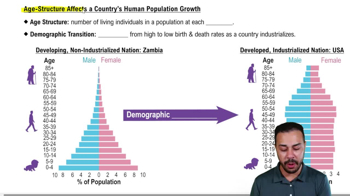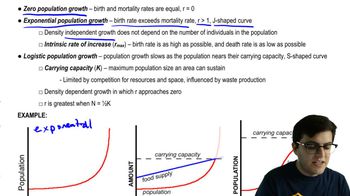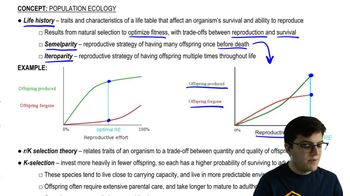Table of contents
- 1. Introduction to Biology2h 40m
- 2. Chemistry3h 40m
- 3. Water1h 26m
- 4. Biomolecules2h 23m
- 5. Cell Components2h 26m
- 6. The Membrane2h 31m
- 7. Energy and Metabolism2h 0m
- 8. Respiration2h 40m
- 9. Photosynthesis2h 49m
- 10. Cell Signaling59m
- 11. Cell Division2h 47m
- 12. Meiosis2h 0m
- 13. Mendelian Genetics4h 41m
- Introduction to Mendel's Experiments7m
- Genotype vs. Phenotype17m
- Punnett Squares13m
- Mendel's Experiments26m
- Mendel's Laws18m
- Monohybrid Crosses16m
- Test Crosses14m
- Dihybrid Crosses20m
- Punnett Square Probability26m
- Incomplete Dominance vs. Codominance20m
- Epistasis7m
- Non-Mendelian Genetics12m
- Pedigrees6m
- Autosomal Inheritance21m
- Sex-Linked Inheritance43m
- X-Inactivation9m
- 14. DNA Synthesis2h 27m
- 15. Gene Expression3h 20m
- 16. Regulation of Expression3h 31m
- Introduction to Regulation of Gene Expression13m
- Prokaryotic Gene Regulation via Operons27m
- The Lac Operon21m
- Glucose's Impact on Lac Operon25m
- The Trp Operon20m
- Review of the Lac Operon & Trp Operon11m
- Introduction to Eukaryotic Gene Regulation9m
- Eukaryotic Chromatin Modifications16m
- Eukaryotic Transcriptional Control22m
- Eukaryotic Post-Transcriptional Regulation28m
- Eukaryotic Post-Translational Regulation13m
- 17. Viruses37m
- 18. Biotechnology2h 58m
- 19. Genomics17m
- 20. Development1h 5m
- 21. Evolution3h 1m
- 22. Evolution of Populations3h 52m
- 23. Speciation1h 37m
- 24. History of Life on Earth2h 6m
- 25. Phylogeny2h 31m
- 26. Prokaryotes4h 59m
- 27. Protists1h 12m
- 28. Plants1h 22m
- 29. Fungi36m
- 30. Overview of Animals34m
- 31. Invertebrates1h 2m
- 32. Vertebrates50m
- 33. Plant Anatomy1h 3m
- 34. Vascular Plant Transport2m
- 35. Soil37m
- 36. Plant Reproduction47m
- 37. Plant Sensation and Response1h 9m
- 38. Animal Form and Function1h 19m
- 39. Digestive System10m
- 40. Circulatory System1h 57m
- 41. Immune System1h 12m
- 42. Osmoregulation and Excretion50m
- 43. Endocrine System4m
- 44. Animal Reproduction2m
- 45. Nervous System55m
- 46. Sensory Systems46m
- 47. Muscle Systems23m
- 48. Ecology3h 11m
- Introduction to Ecology20m
- Biogeography14m
- Earth's Climate Patterns50m
- Introduction to Terrestrial Biomes10m
- Terrestrial Biomes: Near Equator13m
- Terrestrial Biomes: Temperate Regions10m
- Terrestrial Biomes: Northern Regions15m
- Introduction to Aquatic Biomes27m
- Freshwater Aquatic Biomes14m
- Marine Aquatic Biomes13m
- 49. Animal Behavior28m
- 50. Population Ecology3h 41m
- Introduction to Population Ecology28m
- Population Sampling Methods23m
- Life History12m
- Population Demography17m
- Factors Limiting Population Growth14m
- Introduction to Population Growth Models22m
- Linear Population Growth6m
- Exponential Population Growth29m
- Logistic Population Growth32m
- r/K Selection10m
- The Human Population22m
- 51. Community Ecology2h 46m
- Introduction to Community Ecology2m
- Introduction to Community Interactions9m
- Community Interactions: Competition (-/-)38m
- Community Interactions: Exploitation (+/-)23m
- Community Interactions: Mutualism (+/+) & Commensalism (+/0)9m
- Community Structure35m
- Community Dynamics26m
- Geographic Impact on Communities21m
- 52. Ecosystems2h 36m
- 53. Conservation Biology24m
50. Population Ecology
Introduction to Population Ecology
Problem 3c
Textbook Question
Textbook QuestionIf most individuals in a population are young, why is the population likely to grow rapidly in the future? a. Death rates will be low. b. The population has a skewed age distribution. c. Immigration and emigration can be ignored. d. Many individuals will begin to reproduce soon.
 Verified step by step guidance
Verified step by step guidance1
Step 1: Understand the question. The question is asking why a population with a majority of young individuals is likely to grow rapidly in the future.
Step 2: Analyze the options. Option a suggests that death rates will be low. This is a possibility, as younger individuals are generally healthier and less likely to die. However, this doesn't necessarily mean the population will grow rapidly.
Step 3: Consider option b. This option suggests that the population has a skewed age distribution. While this is true, it doesn't explain why the population would grow rapidly.
Step 4: Look at option c. This option suggests that immigration and emigration can be ignored. This is not necessarily true, as these factors can significantly impact population growth.
Step 5: Finally, consider option d. This option suggests that many individuals will begin to reproduce soon. This is the most likely reason why a population with a majority of young individuals would grow rapidly. Young individuals are at or nearing their reproductive age, and as they begin to reproduce, they will add more individuals to the population, causing it to grow rapidly.
Recommended similar problem, with video answer:
 Verified Solution
Verified SolutionThis video solution was recommended by our tutors as helpful for the problem above
Video duration:
1mPlay a video:
Was this helpful?
Key Concepts
Here are the essential concepts you must grasp in order to answer the question correctly.
Age Structure
Age structure refers to the distribution of individuals of different ages within a population. A population with a high proportion of young individuals indicates that many members are approaching reproductive age, which can lead to increased birth rates. This skewed age distribution is crucial for predicting future population growth.
Recommended video:
Guided course

Age-Structure Affects a Country's Human Population Growth
Reproductive Potential
Reproductive potential is the capacity of a population to increase in size through reproduction. In populations with many young individuals, a significant number will soon reach maturity and begin reproducing, contributing to rapid population growth. This concept highlights the importance of age in understanding population dynamics.
Recommended video:
Guided course

Fungi Reproduction - 3
Population Growth Rate
Population growth rate is the rate at which the number of individuals in a population increases over time, often expressed as a percentage. Factors influencing this rate include birth rates, death rates, immigration, and emigration. In a young population, low death rates combined with high birth rates typically result in a rapid increase in population size.
Recommended video:
Guided course

Population Growth Rate vs. Per Capita Population Growth Rate

 1:17m
1:17mWatch next
Master Population Ecology with a bite sized video explanation from Jason Amores Sumpter
Start learningRelated Videos
Related Practice



































































